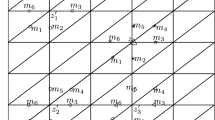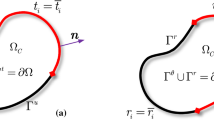Abstract
Explicit asymptotic series describing solutions to the Laplace equation in the vicinity of a circular edge in a three-dimensional domain was recently provided in Yosibash et al. (Int J Fract 168:31–52, 2011). Utilizing it, we extend the quasidual function method (QDFM) for extracting the generalized edge flux intensity functions (GEFIFs) along circular singular edges in the cases of axisymmetric and non-axisymmetric data. This accurate and efficient method provides a functional approximation of the GEFIFs along the circular edge whose accuracy may be adaptively improved so to approximate the exact GEFIFs. It is implemented as a post-solution operation in conjunction with the \(p\)-version of the finite element method. The mathematical analysis of the QDFM is provided, followed by numerical investigations, demonstrating the efficiency, robustness and high accuracy of the proposed quasi-dual function method. The mathematical machinery developed in the framework of the Laplace operator is important to realize its possible extension for the elasticity system.













Similar content being viewed by others
Notes
StressCheck is a trademark of ESRD, St. Louis, USA
References
Babuška I, Miller A (1984) The post-processing approach in the finite element method—part 2: the calculation of stress intensity factors. Int J Numer Methods Eng 20:1111–1129
Blum H, Dobrowolski M (1982) On finite element methods for elliptic equations on domains with corners. Computing 28:53–63
Ciarlet P Jr, Jung B, Kaddouri S, Labrunie S, Zou J (2006) The Fourier singular complement method for the Poisson problem II. Axisymmetric domains. Numer Math 102(4):583–610
Costabel M, Dauge M, Duduchava R (2003) Asymptotics without logarithmic terms for crack problems. Commun PDEs 28(5–6):869–926
Costabel M, Dauge M, Yosibash Z (2004) A quasidual function method for extracting edge stress intensity functions. SIAM J Math Anal 35(5):1177–1202
Dauge M (1988) Elliptic boundary value problems in corner domains—smoothness and asymptotics of solutions. Lecture notes in mathematics, vol 1341. Springer, Heidelberg
Grisvard P (1985) Elliptic problems in nonsmooth domains. Pitman Publishing, England
Irwin GR (1956) Onset of fast crack propagation in high strength steel and aluminum alloys. In: Sagamore research conference proceedings, vol 2, pp 289–305
Irwin GR (1957) Analysis of stresses and strains near the end of a crack transversing a plate. Trans ASME J Appl Mech 24:361–364
Maz’ya VG, Rossmann J (1988) Über die Asymptotik der Lösungen elliptischer Randwertaufgaben in der Umgebung von Kanten. Math Nachr 138:27–53
Omer N, Yosibash Z, Costabel M, Dauge M (2004) Edge flux intensity functions in polyhedral domains and their extraction by a quasidual function method. Int J Fract 129:97–130
Shannon S, Yosibash Z, Dauge M, Costabel M (2012) Primal and shadow functions, dual and dual-shadow functions for a circular crack and a circular \(90^{\circ }\) V-notch with Neumann boundary conditions. Technical report, Open archive: http://hal.archives-ouvertes.fr/hal-00765619
Sneddon IN (1946) The distribution of stress in the neighbourhood of a crack in an elastic solid. Proc R Soc Lond Ser A Math Phys Sci 187:229–260
Yosibash Z, Omer N, Costabel M, Dauge M (2005) Edge stress intensity functions in polyhedral domains and their extraction by a quasidual function method. Int J Fract 136:37–73
Yosibash Z, Shannon S, Dauge M, Costabel M (2011) Circular edge singularities for the Laplace equation and the elasticity system in 3-D domains. Int J Fract 168:31–52
Acknowledgments
Samuel Shannon and Zohar Yosibash gratefully acknowledge the support of this work by the Israel Science Foundation (grant No. 444/10)
Author information
Authors and Affiliations
Corresponding author
Appendices
Appendix A: An explicit expression for \(K_{\infty ,0}^{(1/2)}\) for a circular crack
If we evaluate the successive ratios of the \(\beta _i\)’s in Table 1 we find a simple hypergeometric law.
One can prove that the sequence \(K_{n,0}^{(1/2)}[B_1]\) is converging and compute its limit, as follows. Setting \(Z = \rho e^{\imath \varphi }\), we have
Hence
and since \(\frac{\beta _{i+1}}{\beta _i} = \frac{2i+1}{2(2i+2)}\) (Table 8), we find the limit
Appendix B: Tables with the results of \(J_{\rho _0}[\tau ,K_{n,m}^{(\alpha _j)} [B_{j_q}]]\) for a circular crack with homogeneous Neumann BCs in a non-axisymmetric case
Appendix C: Tables with the results of \(J_{\rho _0}[\tau ,K_{n,m}^{(\alpha _j)} [B_{j_q}]]\) for a circular \(3\pi /2\) V-notch with homogeneous Neumann BCs in a non-axisymmetric case
Rights and permissions
About this article
Cite this article
Shannon, S., Yosibash, Z., Dauge, M. et al. Extracting generalized edge flux intensity functions with the quasidual function method along circular 3-D edges. Int J Fract 181, 25–50 (2013). https://doi.org/10.1007/s10704-013-9817-4
Received:
Accepted:
Published:
Issue Date:
DOI: https://doi.org/10.1007/s10704-013-9817-4




